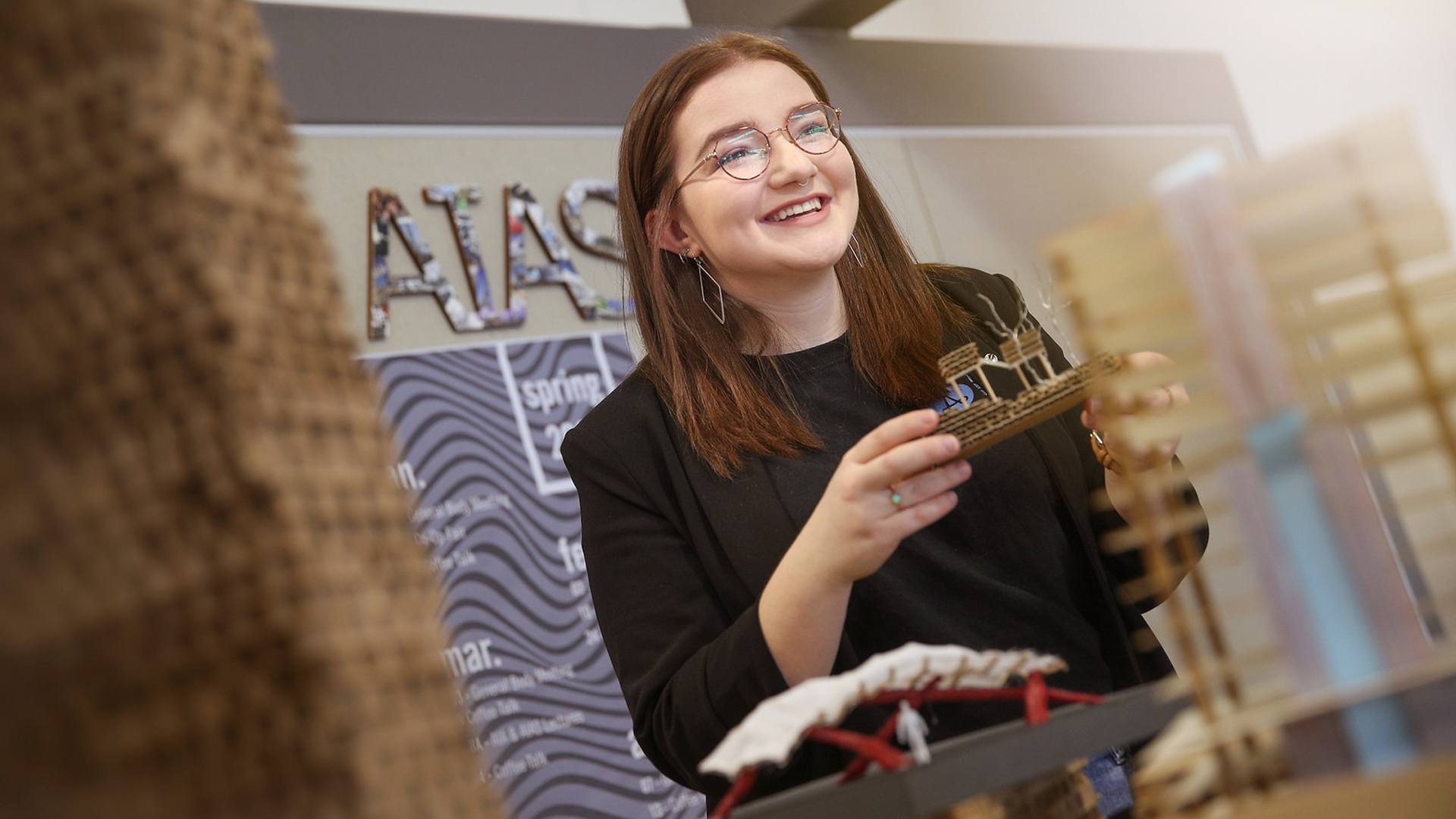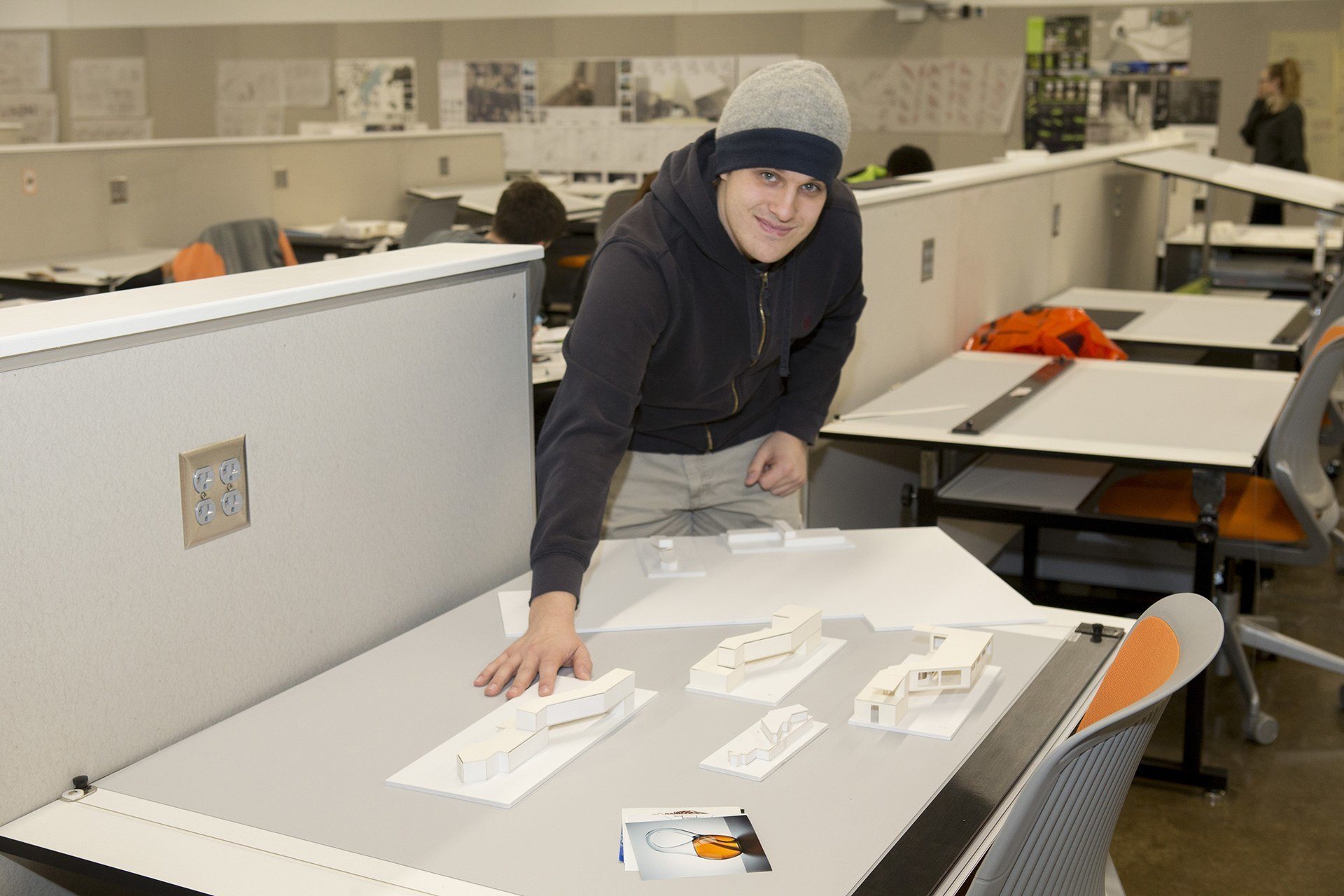
Bachelor of Science in Architecture (B.S.Arch.)
Architecture and Environmental Design
The Bowling Green State University architecture and environmental design major enhances students' problem-solving ability and produces critical thinkers that can address challenges in the built environment.
Students investigate real-world issues, integrate solutions and test alternatives to conventions in a design studio setting.
The Department of Architecture and Environmental Design emphasizes technical expertise and entrepreneurial experience in the architecture and design fields. Those are supplemented with intensive coursework in research, theory, systems, sustainability, structures, materials, methods and professional practice.
Inspiring and empowering students to enhance the global built environment.
The Bachelor of Science in architecture degree at BGSU is a design studio-based learning experience supported by technical coursework covering topics such as computer modeling, construction methods and structures. Our courses focus on student-centered teaching, community-based learning and entrepreneurship.
Architecture coursework incorporates classes from related disciplines such as construction. Elective coursework in art and related fields provides our students with opportunities for a diverse educational experience.
BGSU architecture students participate in two cooperative education experiences as part of the curriculum, enhancing students understanding of real-world architectural practice. The program offers small class sizes and individual attention.
The BGSU architecture program is accredited by the National Architecture Accrediting Board (NAAB) at the graduate level. All architecture and environmental design lectures and design studios are housed in one recently renovated building, allowing for meaningful interactions and collaboration among students, just as in a quality design practice.
The faculty in the Department of Architecture and Environmental Design have national and international practice experience and recognition. BGSU architecture students have the opportunity to collaborate with faculty on developing design competition proposals, several of which have been recognized by design review boards nationally and internationally.
At BGSU, architecture student organizations, including the American Institute of Architecture Students (AIAS) and the National Organization of Minority Architects (NOMAS), are active at the local, regional and national levels.
Majoring in architecture and environmental design at BGSU also provides opportunities for short-term study abroad tours. Previous tours have included London, Paris, Rome, Barcelona, Vancouver and Cabo San Lucas. These experiences enable students to develop an experiential understanding of architectural history and architecture's impact on regional culture in other locations in the world.
Career - what can you do with an architecture and environmental design degree?
Architects are licensed by state bodies. In Ohio, they're licensed by the Ohio Architects Board. The four-year, pre-professional B.S. in architecture degree is ideal preparation for Bowling Green State University’s Master of Architecture (M.Arch.) program, which is accredited by the National Council of Architectural Registration Boards and leads to licensure once the experience and examination components of the licensing process are completed.
An integral component of our undergraduate program is an emphasis on gaining professional experience through paid internships or co-ops. This hands-on learning not only offers invaluable practical experience, but in many cases may lead to the student’s first post-graduation job.
BGSU architecture and environmental design alumni work throughout the design and architecture industry in careers as both qualified architects, construction professionals and environmental designers.
Career paths
- Architect
- Interior designer
- Design visualization specialist
- Building information modeling specialist
- Construction professional
Quick Facts from the Bureau of Labor Statistics
Internships
An integral component of this program is an emphasis on gaining professional experience through paid internships or co-ops. This hands-on learning not only offers invaluable practical experience, but in many cases may lead to the student’s first permanent job.
Curriculum
The mission of the architecture major is to pursue the convergence of technical excellence and liberal arts investigations to inspire and empower students to enhance the built environment.
Students will learn to apply the concepts of architectural theory and history in shaping buildings, cities and other spatial environments – encompassing international traditions as related to aesthetics, environmental impact, society and human behavior.
We teach you to understand the basic principles that inform the design of the structural, material and mechanical/electrical systems is taught, and how to assess, select and integrate such systems into a comprehensive integrated building design. You will become skilled at presenting your designs verbally, graphically and through written and physical representations using the model-making studios.
Discovery, teaching, engagement and service are well-defined in the program’s curriculum. This aligns with the University's and college’s mission to provide educational experiences inside and outside the classroom, as well as provide a culture of applied research and professional service for the good of society.

Sample courses
- Architectural Design Studios
- Computer Modeling for Architecture
- Architectural Building Systems
- Architectural History and Theory
- Cooperative Education
- Elective opportunities in art, sustainability and construction management
The Architecture and Environmental Design program is part of the School of the Built Environment in the BGSU College of Technology, Architecture and Applied Engineering.
Accreditation
Bowling Green State University [BGSU] is accredited by the Higher Learning Commission. BGSU has been accredited by the Higher Learning Commission since 01/01/1916. The most recent reaffirmation of accreditation was received in 2022-2023, with our next reaffirmation of accreditation scheduled for 2032-2033. Questions should be directed to the Office of Institutional Effectiveness.
Request Information
Updated: 08/23/2024 09:48AM

